I got into position a good two hours before dark, and set up on a small, wooded hill a few hundred yards off a newly-planted corn field. I was hog hunting in Yazoo County, Mississippi, this past April, in the middle of the Mississippi Delta, a region of the state famed for its rich, black earth and abundant agriculture. And more recently, tactical hog hunting.
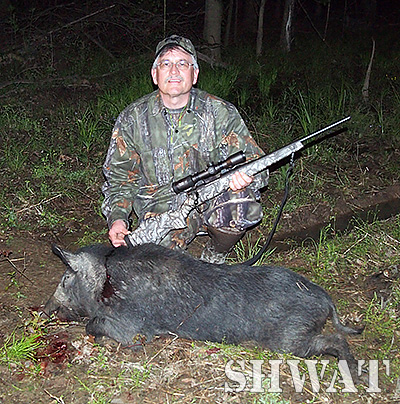 It’s the scene of a huge population explosion–of hogs. While there, I also discovered a growing number of hunters who’ve decided that the tactical approach is one way to tackle their hog problem.
It’s the scene of a huge population explosion–of hogs. While there, I also discovered a growing number of hunters who’ve decided that the tactical approach is one way to tackle their hog problem.
My vantage point on the hill put me smack in the middle of a jungle. Thick, knee-high vegetation. Tree branches above blocked the sunlight and made it gloomy. Huge vines hung down from those same branches.
To my left and below me lay a small creek. The creek wound around to the front of the hill, but at one point a small gully cut off to one side and led to the field. Through my rifle’s scope, I could see the gully’s muddy bottom torn up with tracks; clearly, hogs were using this as an entry into the field.
On my right the land sloped down. I’d approached the hill from that direction, and the earth there was crisscrossed with hog trails and rooted up patches of dirt.
I got into position on the hill, setting up my small chair and getting my Primos Trigger Stick ready, then turning on my ThermaCELL to ward off the mosquitoes. It was a good spot, all the trails and avenues below me leading to the corn field, and hogs were using the field as a regular buffet.
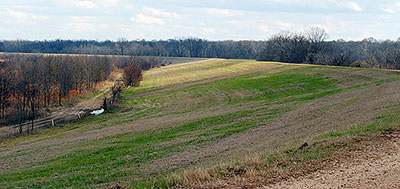 I’d been brought here by Jay Coleman, a local farmer and dedicated hog hunter. This land belongs to Jay’s family, and the 50-acre cornfield in front of my hill had been devastated by hogs over the last several days. We walked in along the edge of the field, and at one point in our hike Coleman stopped and pointed at the neat rows of what looked to me like freshly planted corn.
I’d been brought here by Jay Coleman, a local farmer and dedicated hog hunter. This land belongs to Jay’s family, and the 50-acre cornfield in front of my hill had been devastated by hogs over the last several days. We walked in along the edge of the field, and at one point in our hike Coleman stopped and pointed at the neat rows of what looked to me like freshly planted corn.
“We put the seed in over a week ago,” Coleman explained. “Hogs found out about it three days ago. Went up and down the rows digging out the seed. Damn!”
Then I understood: the rows were not freshly planted, they were freshly dug up. Long hog snouts had rooted up nearly the whole 50 acres of newly seeded corn.
Back on the hill, I had several false alarms, hearing noises but not seeing anything. As it got dark, the sounds increased. Now I was standing up, the Trigger Stick extended about five feet high, my rifle held secure in the rubberized V of the shooting stick. I’d moved to the front edge of the hill, thinking I might catch sight of a hog in the field itself or behind me and coming down slope.
Then I heard it. A rustling and a grunting. Hog!
Problem was, it was nearly dark now, and I didn’t have a light on my rifle. The sounds of hogs moving through the underbrush were getting louder and closer, and I figured there were two, maybe three to the right. Somewhere.
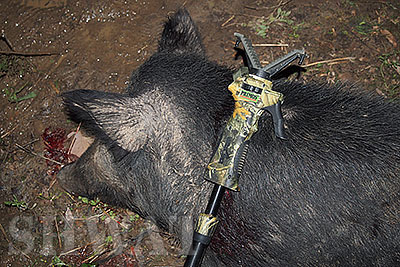 I spun the power ring of my Zeiss Duralyt down to the lowest magnification, 1.25, to grab the most light. I was scanning the darkening land before me, when I suddenly saw him at about 80 yards, a coal black hog. Actually, I think if he was brown, in that light, I would not have seen him. But he stood out just enough, his dark silhouette cutting the gloom. I made out the scope’s crosshairs, barely, laid them on his shoulder and squeezed off a shot.
I spun the power ring of my Zeiss Duralyt down to the lowest magnification, 1.25, to grab the most light. I was scanning the darkening land before me, when I suddenly saw him at about 80 yards, a coal black hog. Actually, I think if he was brown, in that light, I would not have seen him. But he stood out just enough, his dark silhouette cutting the gloom. I made out the scope’s crosshairs, barely, laid them on his shoulder and squeezed off a shot.
A lot happened at once. The black hog toppled over. Somewhere upslope from my hog there was a loud, deep grunting, a crashing and smashing through brush of another hog, and he sounded huge. I worked the bolt of my Weatherby Hog Reaper, chambering another .308 round, when, and at the same time, not 15 yards away, a large white hog squealed in fright and ran around the front of my hill.
I was so focused on the grunting to my right, I apparently missed the white hog sliding in right below me. The hog was moving fast, around brush and tree trunks, a white flash in the dark Mississippi jungle. I moved downhill, came around a large tree and shouldered my rifle. But all I saw was the hog’s white rump as it leapt over a downed tree and disappeared into brush.
Except for my breathing, it was now completely quiet, the air very still. I looked up and saw stars through the leaves. I took a few deep breaths to get my bearings, and headed down hill to find my hog.
You never know where you’ll find a tactical hog hunter, but I found one in the Mississippi Delta in Jay Coleman. As hog numbers zoomed up the last couple years, and hog damage to their crops increased, Coleman and other local farmers in Yazoo County began trapping hogs. It worked pretty well at first. But the hogs became trap smart, and actual catches of them dwindled.
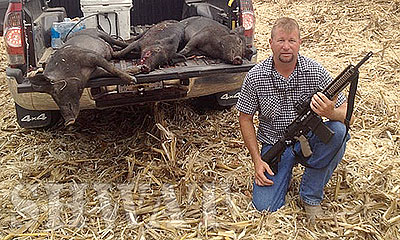 The Mississippi Delta has a long tradition of hog hunting, much of it is with dogs. But dogs can take several hours to bring a single hog to bay. No good when you’re trying to knock back an out-of-control hog population.
The Mississippi Delta has a long tradition of hog hunting, much of it is with dogs. But dogs can take several hours to bring a single hog to bay. No good when you’re trying to knock back an out-of-control hog population.
Hunting is very important tradition in the Delta, and many hogs are taken during deer hunting season. But as the feral hogs were ripping up his fields, Coleman wanted some help now, in the spring and summer when his crops were growing. Fall deer season wasn’t getting it.
According to a recent newspaper article, Mississippi has had pockets of wild hogs for decades. Yet as recently as five years ago, hogs were doing extensive crop damage in only a handful of counties. Now, hogs are found in well over half of Mississippi’s 82 counties; state officials note that they receive complaints of hog crop and property damage almost daily.
“Gets really hot here in the summer,” Coleman told me as we were driving around in search of hogs. “Hot. The hogs lay up way back in the swamps during the day. Once it’s dark, they’re out. In our fields.”
So Coleman and a group of hunting friends started night hunting, using lights attached to the rails of their AR-15s. Within a short time, Coleman and his friends were trying out night vision gear. He liked the NV approach so much, Coleman started selling NV products, especially those made by American Technologies Network Corporation (ATN).
“My biggest sales are the PVS 7, Gen 3 night vision goggles,” Coleman told me. “We’re mounting them to ops core helmets, too. Works great.”
“Isn’t that gear pretty expensive?” I asked.
“It can be pricey,” he admitted. “But it’s a lot cheaper than replanting 50 acres of corn.”
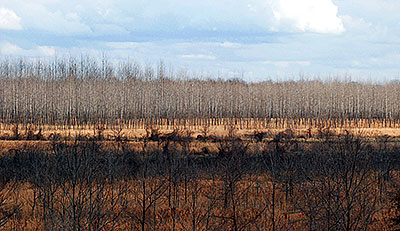 Since my hog hunt in Yazoo County, Coleman tells me sales of his NV equipment are strong and growing, as local farmers increasingly turn to the tactical to reduce hog crop damage. Area hunters have also found out just how much fun it is to take tactical hunting into the night.
Since my hog hunt in Yazoo County, Coleman tells me sales of his NV equipment are strong and growing, as local farmers increasingly turn to the tactical to reduce hog crop damage. Area hunters have also found out just how much fun it is to take tactical hunting into the night.
There are many public hunting lands open to hog hunting in the Mississippi Delta region. As hog numbers keep growing, more and more Mississippi guides are offering hog hunts, too.
Hogs are legally defined as “nuisance animals” in Mississippi, and private landowners can pretty much hunt them as wanted day and night on their own lands. Regulations vary on public lands, so check with the appropriate officials before hunting these public properties. Public or private, you will need a general hunting license to go after hogs.
Like to give Mississippi Delta hogs a try? Start with the Mississippi Tourism’s “Hunting” webpage at: http://visitmississippi.org/hunting. There, you will find a list of hunting outfitters in the state and links to public hunting land information. Travel and lodging information can also be found on Tourism’s main page at http://visitmississippi.org.
I’ll be getting back to the Mississippi Delta as soon as I can for more hog hunting. I believe that parts of the Delta have as many hogs as the most hog-populated areas of Texas. That’s bad news for local famers like Jay Coleman. But it provides many, many opportunities for tactical hog hunters!


Would love to give hog hunting a try where can i get info on a place to go either guided or not? And whats some price ranges?
We’ve enjoyed Spike Box Ranch, though there are other places. Lots of them. If you contact Spike Box, let them know we sent you. It’s been a while since anyone on our staff was there, but it was a great time!